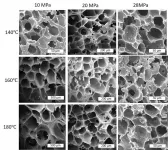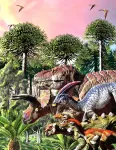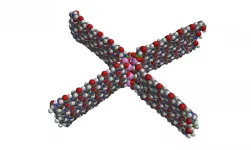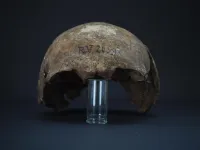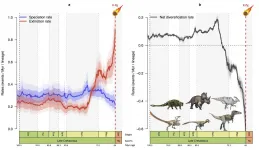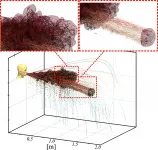CU Anschutz called a 'case study' for commercializing medical breakthroughs
A new paper highlights the academic medical center's record of turning discoveries into innovative products that benefit patients and public health
2021-06-29
(Press-News.org) A new study highlights the University of Colorado Anschutz Medical Campus as an example of how an academic medical center can turn groundbreaking research into commercial products that improve patient care and public health.
The paper, published recently in the Journal of Clinical and Translational Science, focuses on the unique ecosystem at CU Anschutz responsible for these innovations. And it specifically details the campus's collaborative culture and how biomedical research is commercialized.
The campus has successfully turned academic research into a variety of products. CU Anschutz, for example, developed two vaccines for shingles, Zostavax and Shingrix, and worked with industry partners to distribute them globally.
"At the CU Anschutz Medical Campus, we have created an ecosystem that fosters innovation and enables our faculty to turn big ideas into bold breakthroughs with transformative impacts on health and medicine," said Chancellor Donald M. Elliman, Jr. "Our investments in infrastructure and top talent in diverse fields, paired with a focus on building robust industry partnerships, are what allow us to translate research discoveries into new drugs and devices, novel approaches to care delivery and improved outcomes for patients everywhere."
The study notes two major engines driving this innovation: the Colorado Clinical and Translational Sciences Institute (CCTSI) and CU Innovations.
"By sharing best practices for translational research, our hope is to showcase how academic medical centers can develop and disseminate creative solutions to the many challenges facing healthcare systems," said author Ronald Sokol, MD, assistant vice chancellor for Clinical and Translational Science at the CU Anschutz Medical Campus and director of the CCTSI.
CCTSI sets out a road map for faculty that helps them translate research innovation and discoveries into commercially viable products or services. The CU Innovations program collaborates with academic and administrative offices on the campus to identify unique barriers to translation and find creative ways to partner with industry to commercialize discoveries.
"The close collaboration between CU Innovations and the CCTSI with a shared mission of supporting the translation of discoveries has led to major successes," said Kimberly Muller, executive director of CU Innovations. "At CU Innovation's core lies the traditional patent licensing and patent management. However, in recent years greater emphasis has been placed on industry collaborations, providing gap funding, making technology development experts accessible to faculty and offering training programs."
Recently, Summit Biolabs, a commercial-stage molecular diagnostics company, partnered with CU Innovations to collaborate on developing saliva liquid-biopsy tests for early detection of head and neck cancer and diagnosis of viral contagions such as COVID-19. The collaboration involves partnering with CU Anschutz faculty and experts on research, development and commercialization of the tests.
"This collaboration broadens and strengthens Summit Biolabs' ability to bring to market life-changing saliva liquid-biopsy tests that ultimately enable better treatment and improved outcomes for patients," said Bob Blomquist, Chief Executive Officer at Summit Biolabs.
INFORMATION:
About the University of Colorado Anschutz Medical Campus
The University of Colorado Anschutz Medical Campus is a world-class medical destination at the forefront of transformative science, medicine, education, and patient care. The campus encompasses the University of Colorado health professional schools, more than 60 centers and institutes, and two nationally ranked independent hospitals that treat more than two million adult and pediatric patients each year. Innovative, interconnected and highly collaborative, together we deliver life-changing treatments, patient care, professional training, and conduct world-renowned research. For more information, visit http://www.cuanschutz.edu.
[Attachments] See images for this press release:
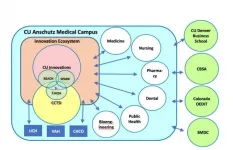
ELSE PRESS RELEASES FROM THIS DATE:
2021-06-29
WASHINGTON, June 29, 2021 -- Biodegradable plastics are supposed to be good for the environment. But because they are specifically made to degrade quickly, they cannot be recycled.
In Physics of Fluids, by AIP Publishing, researchers from the University of Canterbury in New Zealand have developed a method to turn biodegradable plastic knives, spoons, and forks into a foam that can be used as insulation in walls or in flotation devices.
The investigators placed the cutlery, which was previously thought to be "nonfoamable" plastic, into a chamber filled with carbon dioxide. ...
2021-06-29
The death of the dinosaurs 66 million years ago was caused by the impact of a huge asteroid on the Earth. However, palaeontologists have continued to debate whether they were already in decline or not before the impact.
In a new study, published today in the journal Nature Communications, an international team of scientists, which includes the University of Bristol, show that they were already in decline for as much as ten million years before the final death blow.
Lead author, Fabien Condamine, a CNRS researcher from the Institut des Sciences de l'Evolution de Montpellier (France), said: "We looked at the six most abundant dinosaur families through the whole of the Cretaceous, spanning from 150 to 66 million ...
2021-06-29
WASHINGTON, June 29, 2021 -- As wind passes through a turbine, it creates a wake that decreases the downstream average wind velocity. The faster the spin of the turbine blades relative to the wind speed, the greater the impact on the downstream wake profile.
For wind farms, it is important to control upstream turbines in an efficient manner so downstream turbines are not adversely affected by upstream wake effects. In the Journal of Renewable and Sustainable Energy, by AIP Publishing, researchers from the University of Illinois at Urbana-Champaign show by designing controllers based on viewing ...
2021-06-29
WASHINGTON, June 29, 2021 -- Many meteorites, which are small pieces from asteroids, do not experience high temperatures at any point in their existence. Because of this, these meteorites provide a good record of complex chemistry present when or before our solar system was formed 4.57 billion years ago.
For this reason, researchers have examined individual amino acids in meteorites, which come in a rich variety and many of which are not in present-day organisms.
In Physics of Fluids, by AIP Publishing, researchers from Harvard University show the existence of a systematic group of amino acid polymers across several members ...
2021-06-29
The oldest strain of Yersinia pestis--the bacteria behind the plague that caused the Black Death, which may have killed as much as half of Europe's population in the 1300s--has been found in the remains of a 5,000-year-old hunter-gatherer. A genetic analysis publishing June 29 in the journal Cell Reports reveals that this ancient strain was likely less contagious and not as deadly as its medieval version.
"What's most astonishing is that we can push back the appearance of Y. pestis 2,000 years farther than previously published studies suggested," says senior author Ben Krause-Kyora, head of the aDNA Laboratory at the University of Kiel in Germany. ...
2021-06-29
Ten million years before the well-known asteroid impact that marked the end of the Mesozoic Era, dinosaurs were already in decline. That is the conclusion of the Franco-Anglo-Canadian team led by CNRS researcher Fabien Condamine from the Institute of Evolutionary Science of Montpellier (CNRS / IRD / University of Montpellier), which studied evolutionary trends during the Cretaceous for six major families of dinosaurs, including those of the tyrannosaurs, triceratops, and hadrosaurs. Using a novel statistical modelling method that limited bias associated with gaps in the fossil record, they demonstrated that, for dinosaurs 76 million years ...
2021-06-29
WASHINGTON, June 29, 2021 -- Computer simulations have been used with great success in recent months to visualize the spread of the COVID-19 virus in a variety of situations. In Physics of Fluids, by AIP Publishing, researchers explain how turbulence in the air can create surprising and counterintuitive behavior of exhaled droplets, potentially laden with virus.
Investigators from the University of Florida and Lebanese American University carried out detailed computer simulations to test a mathematical theory they developed previously. They found nearly identical exhalations could spread in different ...
2021-06-29
WASHINGTON, June 29, 2021 -- As pervasive as they are in everyday uses, like encryption and security, randomly generated digital numbers are seldom truly random.
So far, only bulky, relatively slow quantum random number generators (QRNGs) can achieve levels of randomness on par with the basic laws of quantum physics, but researchers are looking to make these devices faster and more portable.
In Applied Physics Letters, by AIP Publishing, scientists from China present the fastest real-time QRNG to date to make the devices quicker and more portable. The ...
2021-06-29
What The Study Did: This study describes four patients who presented with acute myocarditis after mRNA COVID-19 vaccination.
Authors: Raymond J. Kim, M.D., of the Duke Cardiovascular Magnetic Resonance Center in Durham, North Carolina, is the corresponding author.
To access the embargoed study: Visit our For The Media website at this link https://media.jamanetwork.com/
(doi:10.1001/jamacardio.2021.2828)
Editor's Note: The article includes conflict of interest disclosures. Please see the articles for additional information, including other authors, author contributions and affiliations, conflicts of interest and financial disclosures, and funding and support.
INFORMATION:
Media advisory: ...
2021-06-29
What The Study Did: Researchers describe myocarditis presenting after COVID-19 mRNA vaccination in 23 patients within the Military Health System.
Authors: Jay Montgomery, M.D., of Walter Reed National Military Medical Center in Bethesda, Maryland, and Margaret Ryan, M.D., M.P.H., of the Naval Medical Center San Diego, are the corresponding authors.
To access the embargoed study: Visit our For The Media website at this link https://media.jamanetwork.com/
(doi:10.1001/jamacardio.2021.2833)
Editor's Note: The article includes conflict of interest disclosures. Please see the articles for additional information, including other authors, author contributions and affiliations, conflicts of interest and financial disclosures, and funding ...
LAST 30 PRESS RELEASES:
[Press-News.org] CU Anschutz called a 'case study' for commercializing medical breakthroughs
A new paper highlights the academic medical center's record of turning discoveries into innovative products that benefit patients and public health

